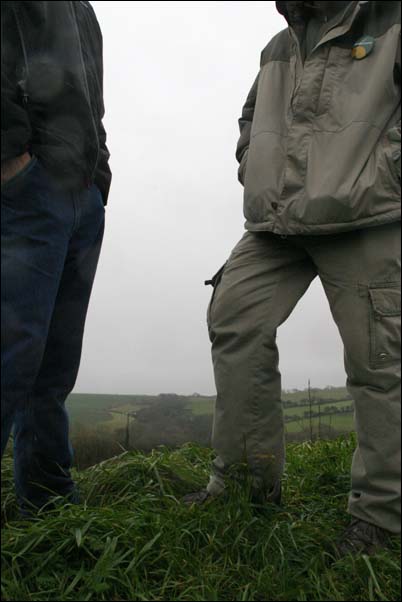
|
Since it was first introduced to Oregon in the early 1990's, the cob building movement in North America has had little contact with its counterpart in the United Kingdom, where the word 'cob' originates from. We were told by our teacher Ianto Evans that there are something like 40,000 cob structures still in use today in the county of Devon alone. So, on my way back to Africa, I extended my stop-over in London to three weeks, so I would have a chance to check out the British cob scene. Over the centuries, like any building, wear and tear will take their toll on old cob structures. Strict building laws in the U.K. demand that the structures be preserved or rebuilt in the same style with the same materials. So, at least half of the work of British natural builders consists of repairing old cob houses. They do this by using 'cob blocks' -- their name for what are essentially adobe bricks -- to patch up the holes in the wall, and using Nader Khalili-style 'helical ties' between the layers -- corkscrew-shape metal rods that function as barbed wire would with earthbags -- giving the wall some shear strength. The reason for the prevalence of cob buildings in Devon is the composition of the subsoil. The earth here is usually a good mix of clay and sand to begin with, and small pebbles are already loosely scattered throughout, providing natural binder and aggregate. All that is needed is to add water and straw, put a few cows in a pen, and let them trudge through the mud until it's well mixed. The cob would be lifted from the mudpile onto the walls with pitchforks, then stomped on and packed down from above, and whacked on the sides to prevent the cob from spalling out. Nowadays, the mixing of the cob, and lifting it onto the wall, is done industrially with a J.C.B., a large tractor with a bucket loader. Up to a metre of cob wall can be built in a day in this fashion, then left to dry for about a week. The 'lifts', or layers, are not sewn together by hand or a 'cobber's thumb' wooden stick, so, in a way, U.K. Cob is somewhat akin to rammed earth, only without the wooden forms -- which the British call "shuttering." The British Isles do not lie in a seismic zone, so tying the layers together is not a great concern for them. Adam Weismann, an American, and Katy Bryce, a Brit, apprenticed with Ianto and the Cob Cottage Company, then returned to the U.K. to practice. They picked up cob restoration skills in Cornwall, West of Devon, then settled here and started up their own cob business. Jill Smallcombe and Jackie Abey and their respective families are British back-to-the-landers of sorts: 'city girls' that moved into 500-year old rural cob farmhouses in Devon, fixed them up, then started making earthen art. They've since built a massive cob complex at the Eden Project, Britain's Biosphere, to educate the public about cob.
 Devon even has its own Intersection Repair, you might say; in fact, that's what started off this whole cob building renaissance 20 years ago. Alfie Howard noticed that the local kids had to wait around in the rain for the bus to come pick them up for school. Before the war, his father had taught him how to build from cob, so he got permission from the town council to build a cob bus shelter, and the rest is history. Since then, there have not been any public structures built from cob in the U.K.; maybe it's time the Yanks returned the favour, and transplant a chapter of City Repair over there! In England, cob building is not intimately tied to ecological consciousness and a leftist lifestyle, the way it is in the United States and Canada. In some ways, it is just the opposite; it is traditionalists that are avid fans of cob, those that long for a United Kingdom of yesteryear. For that reason, there isn't the dogmatic insistence on low embedded-energy methods of construction that many North American practitioners of cob are particularly fond of. Industrial equipment is not considered the bane of cob builders in the U.K., but the means by which they can compete in the capitalist marketplace. I consider myself squarely in the hardcore Deep Ecology camp, because I believe that only when they get their hands and feet all muddy will people have personal transformations. But once you've had that transformation, your task is then to transform the landscape, and the best way to do that may be a combination of low-tech and high-tech methods, while that option is available. I am eager to apply these new lessons sometime soon, and figure out how one might incorporate some of these methods and push the natural building envelope even further. Thanks again to everyone who put up with us, and put us up, as we roamed the English countryside, in search of all things cob, and to Peter Solti, who took a lot of these photographs of beautiful U. K. Cob. Enjoy! Enjoy!
|
